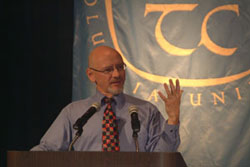James Garbarino: The 2003 Marx Lecturer Speaks on Bullying, Harassment and Emotional Violence
Preview copies of James Garbarino's book, Lost Boys: Why Sons Turn Violent, arrived on the desks of journalists on the same day that the school shootings at Columbine High School took place. Consequently, Garbarino was thrown into the spotlight and his book received lots of attention.
Garbarino, this year's Marx Lecturer, Co-Director of the Family Life Development Center and Elizabeth Lees Vincent Professor of Human Development at Cornell University, used his work related to the Columbine situation as a springboard to his discussion of bullying, harassment and emotional violence.
In the wake of the Columbine killings, the Klebolds, the parents of one of the boys who killed his fellow students, contacted Garbarino to ask him to serve as an expert witness in lawsuits against them. They also wanted desperately to understand how the son they had loved and cared about, and whom they tried to provide with the best upbringing they could, would end up becoming a mass murderer in a nightmarish scene viewed by the whole world.
After conducting what he called a "psychological autopsy" on the Klebolds' son, Dylan, Garbarino concluded that there was no simple causal line that could be drawn from his parents to his role as a mass murderer.
"It was impossible to understand Dylan as a killer without understanding Dylan as a student at Columbine High School," Garbarino said. "Without what happened at school, you still might have had a troubled boy, but I don't think you would have had a killer." It is the toxic atmosphere at schools, he added, that contributes to the downfall of kids like Dylan.
"The school as a social system can breed violence, alienation and depression or hope, good feeling and character," he explained.
What Garbarino said he finds most bizarre about the current interest in the topic of bullying and harassment is that it is a "new" issue in the major consciousness. "We are finally starting to see something before our eyes that has been invisible for such a long time," he said.
According to Garbarino, research on boys indicates that one-third of them are involved in bullying at any particular time-either as bullies or as victims. Onlookers to a bullying incident, he said, are as much traumatized as the victims-they fear they also will be victims and they feel guilty for not doing something against the violence.
Why can we address this issue now, if, as he says, it has been there all along? "Before you can see it perceptively," Garbarino said, "You have to see it cognitively. You can't diagnose something unless you believe it exists."
Often, incidents of bullying and harassment are accepted and tolerated because they are seen as a rite of passage and is believed by some to be "good for kids."
Efforts to address problems of troublesome young people, Garbarino says, have been misguided because they are easy to fund and sponsor but don't really solve the problem. Programs like "Scared Straight," which used career criminals to scare kids into staying out of prison made high-risk kids worse. For the most part, those kids simply realized just how tough they would have to be if they went to prison.
"You can change the world," Garbarino said repeatedly, "but unless you know what you are doing, please don't."
Garbarino spoke about themes to guide intervention. One theme was the temperamental aspects of bullying-that victims tend to be temperamentally sensitive, bullies tend to be insensitive. When insensitive kids are yelled at for their behavior, they don't care.
But why do some victims snap as a result of being bullied and harassed and others deal more effectively with those incidents? Research shows that the environment can alter the effects of the sensitivities. The child's life as a whole, the accumulated experiences of stress they have to deal with at any one time are what matter. It is what he called the accumulation of risk factors versus assets.
Risk factors and assets, he explained, are what are inside a kid's head, including what they experience in the family, in school, and culturally. "Most kids can be resilient with one or two risk factors. The more risk factors in their life, the more of a problem things become," Garbarino said. The average young person, he said, can handle two risk factors, but is in trouble when that increases to four.
Schools often deny that bullying and harassment are a problem. The same behaviors, if experienced in the business world, would be addressed quite differently. "[Businesses] say, ‘We are going to do something about this,' because they are liable to protect your human rights," Garbarino noted. "These things happen to kids in school every day. They arrive at school exhausted after being harassed or in fear of it."
He suggests that in order to make bullying and harassment antithetical, it is necessary to create a positive environment. "Most people base their behavior on becoming congruent with what the setting encourages," he said. "The whole system can be set up to promote harmony so that bullying and harassment are the aberration."
Published Sunday, Nov. 30, 2003
